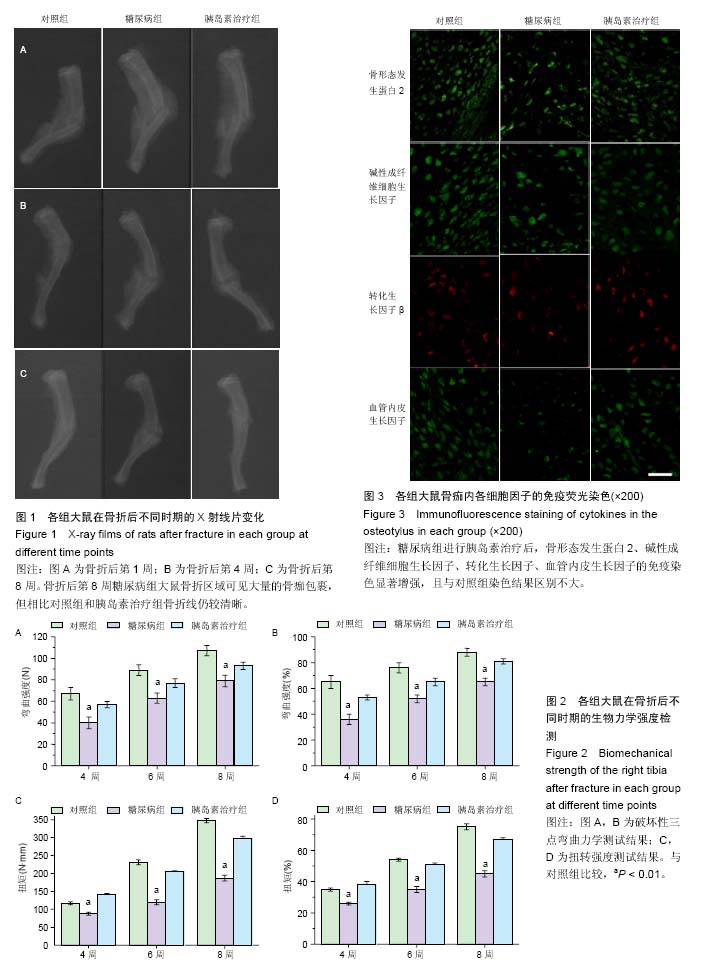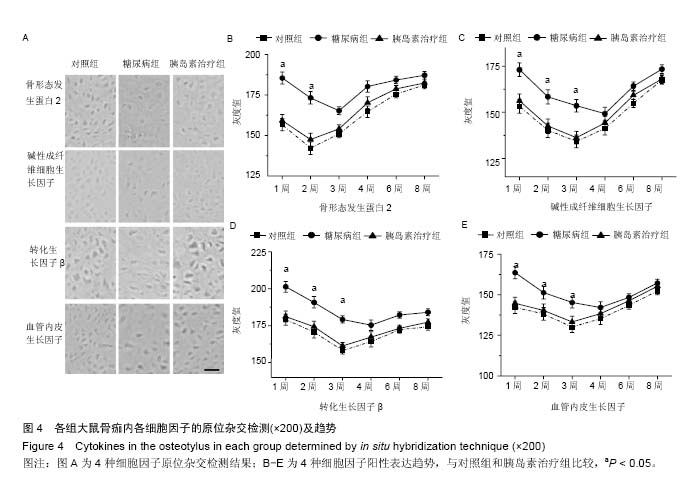| [1] Ishikawa K, Fukui T, Nagai T,et al.Type 1 diabetes patients have lower strength in femoral bone determined by quantitative computed tomography: A cross-sectional study. J Diabetes Investig. 2015;6(6): 726-733.
[2] 李溪,向盈盈,龚跃昆,等. 糖尿病骨折大鼠骨痂组织中成骨细胞增殖和骨钙素表达与骨形态发生蛋白2干预的关系[J].中国组织工程研究与临床康复, 2009, 13(20): 3857-3861.
[3] Zhang Q, Dong H, Li Y,et al. Microgrooved Polymer Substrates Promote Collective Cell Migration To Accelerate Fracture Healing in an in Vitro Model. ACS applied materials & interfaces.2015;7(41):23336-23345.
[4] Takeyama K,Chatani M,Takano Y,et al.In-vivo imaging of the fracture healing in medaka revealed two types of osteoclasts before and after the callus formation by osteoblasts.Developmental biology.2014;394(2): 292-304.
[5] Murata K,Ito H,Yoshitomi H,et al.Inhibition of miR-92a enhances fracture healing via promoting angiogenesis in a model of stabilized fracture in young mice.J Bone Miner Res.2014;29(2):316-326.
[6] Wang CY, Yang HB, Hsu HS,et al. Mesenchymal stem cell-conditioned medium facilitates angiogenesis and fracture healing in diabetic rats. Journal of tissue engineering and regenerative medicine. 2012;6(7): 559-569.
[7] Alblowi J, Tian C, Siqueira MF,et al.Chemokine expression is upregulated in chondrocytes in diabetic fracture healing. Bone. 2013;53(1):294-300.
[8] Kottstorfer J,Kaiser G,Thomas A,et al.The influence of non-osteogenic factors on the expression of M-CSF and VEGF during fracture healing. Injury.2013;44(7): 930-934.
[9] 马骋,高岩,苟三怀,等.神经生长因子对大鼠胫骨骨折愈合的影响[J].中国组织工程研究与临床康复,2008, 12(46): 9032-9035.
[10] Krakauer JC, McKenna MJ, Buderer NF,et al.Bone loss and bone turnover in diabetes.Diabetes. 1995; 44(7):775-782.
[11] Krakauer JC, McKenna MJ, Rao DS,et al. Bone mineral density in diabetes. Diabetes care. 1997; 20(8):1339-1340.
[12] Li R,Nauth A,Gandhi R,et al.BMP-2 mRNA expression after endothelial progenitor cell therapy for fracture healing. J Orthop Trauma.2014;28 Suppl 1:S24-27.
[13] Saito W, Uchida K, Matsushita O,et al.Acceleration of callus formation during fracture healing using basic fibroblast growth factor-kidney disease domain- collagen-binding domain fusion protein combined with allogenic demineralized bone powder. Journal of orthopaedic surgery and research. 2015;10:59.
[14] Poniatowski LA,Wojdasiewicz P,Gasik R,et al. Transforming growth factor Beta family: insight into the role of growth factors in regulation of fracture healing biology and potential clinical applications. Mediators of inflammation.2015;2015:137823.
[15] Wang CJ,Huang KE,Sun YC,et al.VEGF modulates angiogenesis and osteogenesis in shockwave- promoted fracture healing in rabbits. J Surg Res. 2011; 171(1):114-119.
[16] Levy JR, Murray E, Manolagas S,et al. Demonstration of insulin receptors and modulation of alkaline phosphatase activity by insulin in rat osteoblastic cells. Endocrinology.1986;119(4):1786-1792.
[17] 李溪,向盈盈,龚跃昆,刘劲松.胰岛素样生长因子1在糖尿病骨折大鼠骨痂组织中对成骨细胞增殖和骨钙素表达的影响[J].中国组织工程研究与临床康复, 2009, (15):2865-2868.
[18] Feng X, Huang D, Lu X,et al. Insulin-like growth factor 1 can promote proliferation and osteogenic differentiation of human dental pulp stem cells via mTOR pathway.Development, growth & differentiation. 2014;56(9):615-624.
[19] Chen Y, Ke J, Long X,et al.Insulin-like growth factor-1 boosts the developing process of condylar hyperplasia by stimulating chondrocytes proliferation. Osteoarthritis and cartilage / OARS, Osteoarthritis Research Society.2012;20(4):279-287.
[20] Petrou M, Niemeyer P, Stoddart MJ,et al.Mesenchymal stem cell chondrogenesis: composite growth factor-bioreactor synergism for human stem cell chondrogenesis. Regenerative medicine. 2013;8(2): 157-170.
[21] Wong MC, Leung MC, Tsang CS,et al. The rising tide of diabetes mellitus in a Chinese population: a population-based household survey on 121,895 persons. Int J Public Health.2013;58(2):269-276.
[22] Driessen JH,van Onzenoort HA,Henry RM, et al.Use of dipeptidyl peptidase-4 inhibitors for type 2 diabetes mellitus and risk of fracture. Bone.2014;68:124-30.
[23] Mishima T,Motoyama K,Imanishi Y,et al.Decreased cortical thickness, as estimated by a newly developed ultrasound device, as a risk for vertebral fracture in type 2 diabetes mellitus patients with eGFR of less than 60 mL/min/1.73 m2. Osteoporos Int. 2015;26(1): 229-236.
[24] Liao CC,Lin CS,Shih CC,et al.Increased risk of fracture and postfracture adverse events in patients with diabetes: two nationwide population-based retrospective cohort studies. Diabetes care. 2014; 37(8):2246-2252.
[25] Roy B.Biomolecular basis of the role of diabetes mellitus in osteoporosis and bone fractures. World J Diabetes. 2013;4(4):101-113.
[26] Kayal RA,Siqueira M,Alblowi J, et al.TNF-alpha mediates diabetes-enhanced chondrocyte apoptosis during fracture healing and stimulates chondrocyte apoptosis through FOXO1. J Bone Miner Res. 2010; 25(7):1604-1615.
[27] Lee SN,Lee DH,Lee MG,et al.Proprotein convertase 5/6a is associated with bone morphogenetic protein-2-induced squamous cell differentiation. Am J Respir Cell Mol Biol. 2015;52(6):749-761.
[28] 徐晓峰,李阳,钱栋,等.骨形态发生蛋白2和血管内皮生长因子mRNA在股骨骨不连大鼠损伤区域的动态表达[J].中国组织工程研究与临床康复,2010, 14(37): 6857- 6860.
[29] Hughes-Fulford M, Li CF. The role of FGF-2 and BMP-2 in regulation of gene induction, cell proliferation and mineralization. J Orthop Surg Res. 2011;6:8.
[30] Cals FL,Hellingman CA,Koevoet W,et al.Effects of transforming growth factor-beta subtypes on in vitro cartilage production and mineralization of human bone marrow stromal-derived mesenchymal stem cells. J Tissue Eng Regen Med..2012;6(1):68-76.
[31] Kazemi-Lomedasht F,Behdani M,Bagheri KP,et al.Inhibition of angiogenesis in human endothelial cell using VEGF specific nanobody.Molecular Immunology. 2015;65(1):58-67.
[32] Chamorro-Jorganes A, Lee MY, Araldi E,et al. VEGF-Induced Expression of miR-17~92 Cluster in Endothelial Cells is Mediated by ERK/ELK1 Activation and Regulates Angiogenesis. Circ Res. 2016;118(1): 38-47.
[33] Blakytny R, Spraul M, Jude EB. Review: The diabetic bone: a cellular and molecular perspective. Int J Low Extrem Wounds. 2011;10(1):16-32.
[34] Courcoulas AP,Belle SH,Neiberg RH,et al.Three-Year Outcomes of Bariatric Surgery vs Lifestyle Intervention for Type 2 Diabetes Mellitus Treatment: A Randomized Clinical Trial. JAMA surgery.2015;150(10):931-940.
[35] Pramojanee SN,Phimphilai M,Chattipakorn N,et al. Possible roles of insulin signaling in osteoblasts. Endocrine research.2014;39(4):144-151. |
.jpg) 文题释义:
细胞因子:是指主要由免疫细胞分泌的、能调节细胞功能的小分子多肽。在免疫应答过程中,细胞因子对于细胞间相互作用、细胞的生长和分化有重要调节作用。由于基因工程、细胞工程研究的飞速发展,不仅克隆了早先发现的生物活性肽的cDNA,而且发现了许多新的细胞因子,并对各种细胞因子产生来源、分了子结构和基因、相应的受体、生物学功能以及与临床的关系等进行了大量的研究,成为当今基础免疫学和临床免疫学研究中一个活跃的领域。
胰岛素:胰岛素是由胰脏内的胰岛β细胞受内源性或外源性物质刺激而分泌的一种蛋白质激素。胰岛素作为降糖药物被广泛作用于临床,是机体内降低血糖的最关键激素,研究还发现它同时具备促进骨组织再生的特性。
文题释义:
细胞因子:是指主要由免疫细胞分泌的、能调节细胞功能的小分子多肽。在免疫应答过程中,细胞因子对于细胞间相互作用、细胞的生长和分化有重要调节作用。由于基因工程、细胞工程研究的飞速发展,不仅克隆了早先发现的生物活性肽的cDNA,而且发现了许多新的细胞因子,并对各种细胞因子产生来源、分了子结构和基因、相应的受体、生物学功能以及与临床的关系等进行了大量的研究,成为当今基础免疫学和临床免疫学研究中一个活跃的领域。
胰岛素:胰岛素是由胰脏内的胰岛β细胞受内源性或外源性物质刺激而分泌的一种蛋白质激素。胰岛素作为降糖药物被广泛作用于临床,是机体内降低血糖的最关键激素,研究还发现它同时具备促进骨组织再生的特性。.jpg) 文题释义:
细胞因子:是指主要由免疫细胞分泌的、能调节细胞功能的小分子多肽。在免疫应答过程中,细胞因子对于细胞间相互作用、细胞的生长和分化有重要调节作用。由于基因工程、细胞工程研究的飞速发展,不仅克隆了早先发现的生物活性肽的cDNA,而且发现了许多新的细胞因子,并对各种细胞因子产生来源、分了子结构和基因、相应的受体、生物学功能以及与临床的关系等进行了大量的研究,成为当今基础免疫学和临床免疫学研究中一个活跃的领域。
胰岛素:胰岛素是由胰脏内的胰岛β细胞受内源性或外源性物质刺激而分泌的一种蛋白质激素。胰岛素作为降糖药物被广泛作用于临床,是机体内降低血糖的最关键激素,研究还发现它同时具备促进骨组织再生的特性。
文题释义:
细胞因子:是指主要由免疫细胞分泌的、能调节细胞功能的小分子多肽。在免疫应答过程中,细胞因子对于细胞间相互作用、细胞的生长和分化有重要调节作用。由于基因工程、细胞工程研究的飞速发展,不仅克隆了早先发现的生物活性肽的cDNA,而且发现了许多新的细胞因子,并对各种细胞因子产生来源、分了子结构和基因、相应的受体、生物学功能以及与临床的关系等进行了大量的研究,成为当今基础免疫学和临床免疫学研究中一个活跃的领域。
胰岛素:胰岛素是由胰脏内的胰岛β细胞受内源性或外源性物质刺激而分泌的一种蛋白质激素。胰岛素作为降糖药物被广泛作用于临床,是机体内降低血糖的最关键激素,研究还发现它同时具备促进骨组织再生的特性。


.jpg) 文题释义:
细胞因子:是指主要由免疫细胞分泌的、能调节细胞功能的小分子多肽。在免疫应答过程中,细胞因子对于细胞间相互作用、细胞的生长和分化有重要调节作用。由于基因工程、细胞工程研究的飞速发展,不仅克隆了早先发现的生物活性肽的cDNA,而且发现了许多新的细胞因子,并对各种细胞因子产生来源、分了子结构和基因、相应的受体、生物学功能以及与临床的关系等进行了大量的研究,成为当今基础免疫学和临床免疫学研究中一个活跃的领域。
胰岛素:胰岛素是由胰脏内的胰岛β细胞受内源性或外源性物质刺激而分泌的一种蛋白质激素。胰岛素作为降糖药物被广泛作用于临床,是机体内降低血糖的最关键激素,研究还发现它同时具备促进骨组织再生的特性。
文题释义:
细胞因子:是指主要由免疫细胞分泌的、能调节细胞功能的小分子多肽。在免疫应答过程中,细胞因子对于细胞间相互作用、细胞的生长和分化有重要调节作用。由于基因工程、细胞工程研究的飞速发展,不仅克隆了早先发现的生物活性肽的cDNA,而且发现了许多新的细胞因子,并对各种细胞因子产生来源、分了子结构和基因、相应的受体、生物学功能以及与临床的关系等进行了大量的研究,成为当今基础免疫学和临床免疫学研究中一个活跃的领域。
胰岛素:胰岛素是由胰脏内的胰岛β细胞受内源性或外源性物质刺激而分泌的一种蛋白质激素。胰岛素作为降糖药物被广泛作用于临床,是机体内降低血糖的最关键激素,研究还发现它同时具备促进骨组织再生的特性。